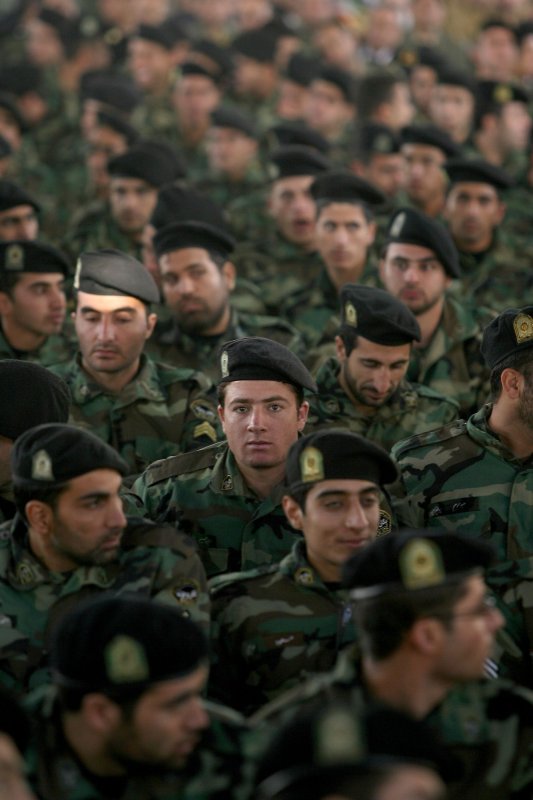Members of Iran's elite Revolutionary Guards attend a celebration to mark the anniversary of Islamic revolution at the Behesht-e Zahra (Zahra's paradise) cemetery in southern Tehran, Iran on February 1, 2010. The celebration is to mark the 1979 return of Ayatollah Khomeini from exile. UPI/Maryam Rahmanian |
License Photo
DUBAI, United Arab Emirates, Sept. 13 (UPI) -- If the United States or Israel attacks Iran, a key figure in unleashing the threatened retaliation by Tehran is a general in the Revolutionary Guards who until quite recently was little known, even to Western intelligence services.
Brig. Gen. Qassem Suleimani, who commands the Guards Corps' elite and largely clandestine al-Quds Force, has long been the invisible man in Iran's intelligence hierarchy and an enigma to the U.S. intelligence community that is one of his main adversaries.
He's hailed as a national hero in Iran but has rarely been seen in public.
Until recently the Americans and their allies knew little about him.
Former CIA officer Philip Giraldi, who spent years operating undercover in the Middle East in the 1980s when Iran was conducting constant "black operations" across the region, recalls that, although Suleimani was involved in these spying and assassination missions, he was "pretty much unknown to U.S. intelligence."
Giraldi said there was a file on the general at CIA headquarters in Langley, Va., at that time "but it was pretty much empty."
These days, the Americans have come to appreciate how dangerous Suleiman is and how crucial a role he plays in Iran's growing power in the Middle East and its environs.
The U.S. Treasury Department has branded him and his entire military command terrorists.
In March 2008, the general brokered a truce in a major battle in the southern Iraqi city of Basra, near the country's main oilfields, between the Mehdi Army, the militia of firebrand Shiite cleric Moqtada Sadr, and the security forces of the Shiite-dominated Baghdad government of Prime Minister Nouri al-Maliki that was in danger of escalating into a full-scale uprising by Sadr's followers.
Suleimani's success underlined the authority and power he wields in the notoriously opaque Tehran regime and in Iraq. More importantly, his actions illustrate how this perplexing figure is so adept at meshing covert, aggressive operations with strategic diplomacy.
Suleimani's al-Quds Force is responsible for all the Tehran regime's clandestine operations abroad. These range from setting up sleeper cells around the globe -- a network likely to be activated if Iran is attacked -- to assassinating enemies of the regime and providing funds, arms and training for militant groups such as Hezbollah.
Israeli analyst Yossi Melman, an authority on intelligence matters, says the general has "prominent status" within Iran's powerful intelligence-security establishment.
"Suleimani is a quintessential product of the revolution who has spent most of his professional career in the ranks of the Revolutionary Guards," Melman observed.
The general was able to impose the Basra cease-fire because it was his al-Quds Force that armed and trained Iraqi groups in furtherance of Tehran's grand design to dominate Iraq following Saddam Hussein's demise.
Suleimani, says Washington Post columnist David Ignatius, "represents the sharp point of the Iranian spear … He's also Iran's leading strategist on foreign policy."
The Basra episode was a perfect example of how "Suleimani has been adept at turning up the heat in Iraq, then lowering the temperature when it suits Iran's interests," Ignatius wrote.
Little is known of Suleimani's early life but he is believed to have been born March 11, 1957, in the holy city of Qom. After Shah Mohammad Reza Pahlavi was toppled in the Islamic Revolution in 1979, Suleimani joined the Revolutionary Guards, formed to protect the new fundamentalist regime.
When Saddam invaded Iran Sept. 22, 1980, Suleimani was a green lieutenant. But he quickly distinguished himself in battle, often on missions behind Iraqi lines. When the war ended in 1988 he commanded the guards' 41st Tharallah Division.
In 2000, he was given command of al-Quds Force, which has been linked to most of the terrorist incidents over the last three decades in which an Iranian hand was detected.
Western intelligence sources say Suleimani headed covert operations in Bosnia during the Balkan wars of the 1990s and in Central Asia. In 1996 he was operating in Afghanistan.
It was only in 2002, when he stepped out of the shadows and accompanied Iranian President Mohammad Khatami to Kabul that the Americans took notice of this enigmatic figure who would cause them such distress in Iraq.





